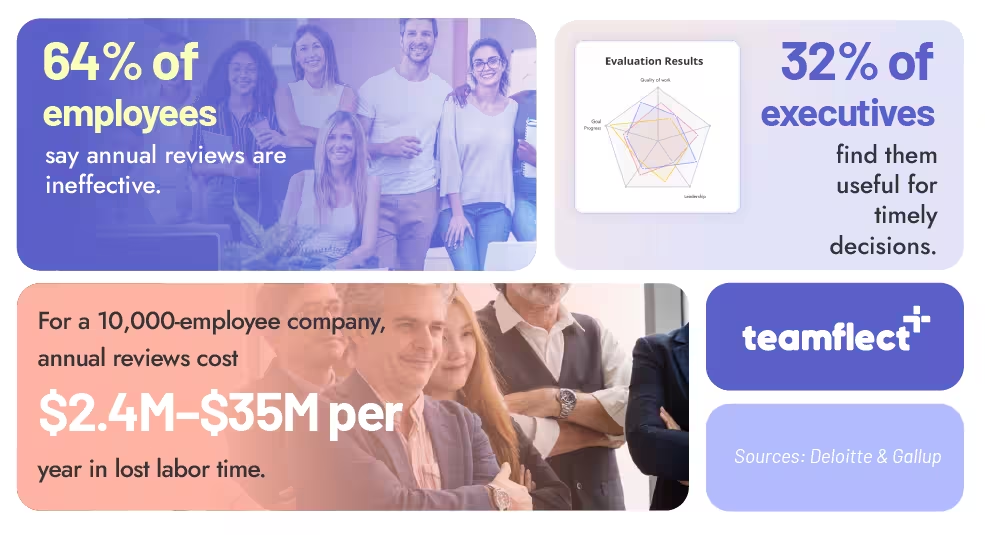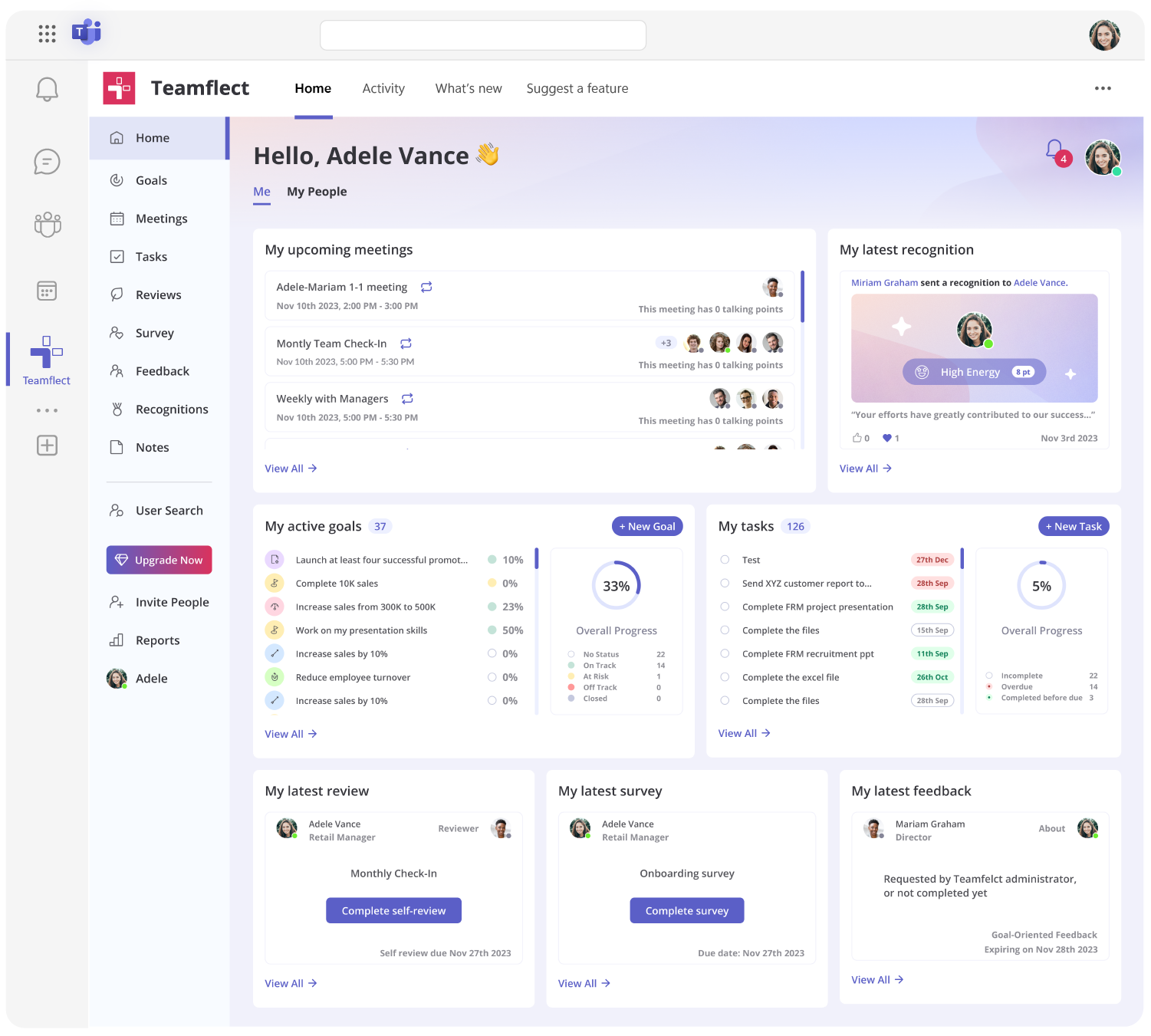Traditional annual performance reviews no longer meet modern workplace demands. According to Deloitte, most employees within an organization find them a waste of time. In fact, 64% of employees view them as ineffective, and only 32% of executives find them useful for timely talent decisions.
Therefore, you should switch to an approach that continuously tracks employee performance.
The focus needs to change to include immediate feedback, consistent goal setting, and the use of data to help employees improve and plan their workforce strategies.
With this, we created this guide to help you improve how you track your performance, including the best strategies, tools, and key numbers for 2025.
Performance tracking is the process of monitoring and measuring employee progress toward goals and organizational objectives. This is done through ongoing data collection and feedback.
Traditional annual reviews focus on past performance and can be costly. According to Gallup, for a company with 10,000 employees, these reviews can cost between $2.4 million and $35 million each year in lost labor time.
Modern performance tracking methods, on the other hand, provide real-time insights. These insights support employee development, goal alignment, and more cost-effective performance management.
The table below summarizes the comparison between the two approaches:

Performance tracking fosters accountability, helping employees understand expectations, celebrate achievements, and address challenges early.
Here are specific reasons why employee performance tracking matters for your employees and for your organization:
Strategic workforce planning benefits from reliable, ongoing performance data that highlights skill gaps, top talent, and succession readiness. It supports well-informed decisions regarding training investments, promotions, and hiring:
Performance tracking systems make professional development goals more achievable by tracking progress, identifying barriers, and providing opportunities for timely course correction.
Key elements that contribute to improved development outcomes include:
Effective performance tracking facilitates data-driven recognition and helps align employee efforts with organizational objectives. Companies that acknowledge and reward their employees, as reported by SHRM, see a 31% drop in employee turnover rate because employees feel valued, connected, and understand their career progression.
Real-time performance insights give managers the flexibility to monitor team capacity, project progress, and goal achievement as they happen. With these insights, managers can quickly reallocate resources, shift priorities, and offer targeted support without waiting for scheduled reviews.
Such agility leads to:
Performance tracking provides objective, data-backed insights into individual contributions, goal achievement, and skill growth. It supports fair promotion and salary decisions by reducing bias and ensuring high performers are rewarded appropriately.
The approach fosters:
Effective performance tracking requires systematic approaches that balance measurement with development, providing clear expectations while supporting employee growth and engagement.
Setting clear and measurable goals means defining specific objectives that provide a focused target with quantifiable criteria for success, aligned to organizational priorities and achievable within a set timeframe.
Regular one-on-one meetings, held weekly or biweekly, help managers and employees align on goals and address obstacles. These meetings turn performance management into an ongoing conversation. They replace outdated annual reviews and enable timely feedback and proactive support.
Tech companies like Microsoft and Adobe replaced annual reviews with frequent one-on-ones, which boosted employee satisfaction, sped issue resolution, and strengthened manager-employee connections.

There are plenty of different tools you can use to make sure your one-on-one meetings are as effective as possible. If you are conducting your one-on-ones through Microsoft Teams, then the best one-on-one meeting software for you is Teamflect.
Teamflect's one-on-one feature allows for;
Continuous feedback involves gathering and sharing input regularly from peers, managers, and stakeholders to provide a holistic view of performance. It expands perspective beyond traditional top-down reviews, fostering a culture of real-time appreciation and growth.
Real-time goal tracking offers immediate visibility into progress, allowing managers and employees to address challenges promptly and maintain momentum. It prevents end-of-cycle surprises and optimizes resource allocation.
Timely recognition of accomplishments reinforces positive behaviors and motivates continued high performance. Employee reward systems should balance monetary and non-monetary incentives, catering to diverse preferences and fostering a supportive culture.
Companies adopt monthly achievement celebrations and multi-faceted awards programs recognizing innovation, collaboration, and leadership to nurture a culture of appreciation.

Modern performance tracking demands integrated platforms that unify goal setting, feedback, recognition, and development all within tools teams use daily. Teamflect offers a seamless performance management solution built directly into Microsoft Teams, streamlining processes and boosting adoption.
This integration eliminates the friction typically associated with separate performance management software systems while ensuring consistent usage across organizations.
Key Teamflect features include:
Performance metrics are essential tools for assessing employee and organizational performance. Different types of metrics capture various dimensions of work, from outcomes to behaviors and future predictions. Understanding these categories helps create a balanced and effective performance tracking system.
Performance tracking is the specific process of continuously monitoring an employee's progress toward their goals.
On the other hand, performance management is a broader process that uses this tracking data to support employee growth through goal setting, development planning, and formal evaluations.
Performance should be tracked continuously, often through weekly or bi-weekly check-ins. While formal evaluations may happen quarterly or annually, the tracking itself should be ongoing to provide a clear view of an employee's progress throughout the year.
The best metrics combine a few different factors:
These metrics should be specific to the role and measurable.
Common challenges include inconsistent manager participation, unclear performance standards, and a lack of proper technology. Organizations can address these by training managers, setting clear expectations, and using integrated technology solutions.
Performance tracking shifts focus from annual reviews to continuous development that drives individual growth and business success. It integrates clear goals, ongoing feedback, real-time progress monitoring, and regular recognition through seamless technology platforms.
Implementing this requires leadership support, manager training, and tools like Teamflect that embed performance conversations into everyday workflows.
An all-in-one performance management tool for Microsoft Teams
